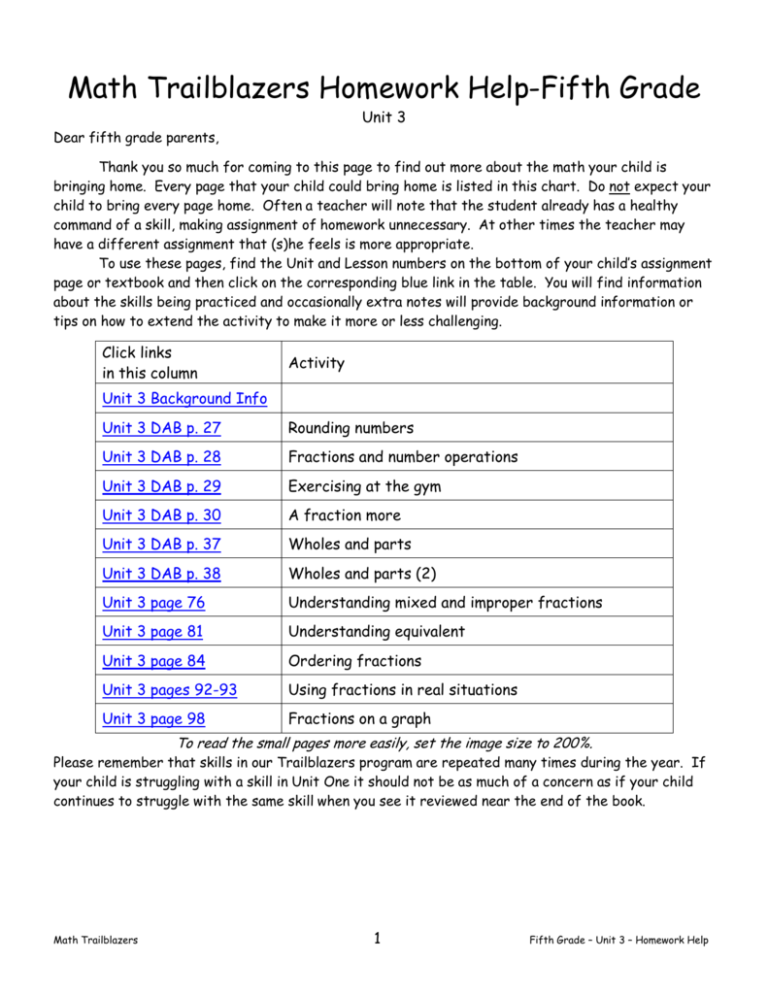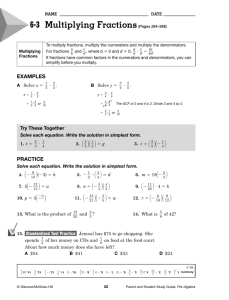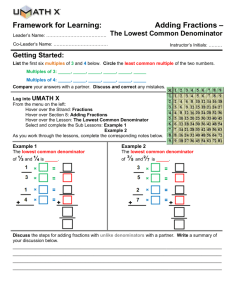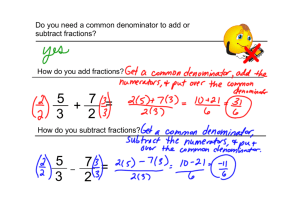Unit 3
advertisement

Math Trailblazers Homework Help-Fifth Grade Unit 3 Dear fifth grade parents, Thank you so much for coming to this page to find out more about the math your child is bringing home. Every page that your child could bring home is listed in this chart. Do not expect your child to bring every page home. Often a teacher will note that the student already has a healthy command of a skill, making assignment of homework unnecessary. At other times the teacher may have a different assignment that (s)he feels is more appropriate. To use these pages, find the Unit and Lesson numbers on the bottom of your child’s assignment page or textbook and then click on the corresponding blue link in the table. You will find information about the skills being practiced and occasionally extra notes will provide background information or tips on how to extend the activity to make it more or less challenging. Click links in this column Activity Unit 3 Background Info Unit 3 DAB p. 27 Rounding numbers Unit 3 DAB p. 28 Fractions and number operations Unit 3 DAB p. 29 Exercising at the gym Unit 3 DAB p. 30 A fraction more Unit 3 DAB p. 37 Wholes and parts Unit 3 DAB p. 38 Wholes and parts (2) Unit 3 page 76 Understanding mixed and improper fractions Unit 3 page 81 Understanding equivalent Unit 3 page 84 Ordering fractions Unit 3 pages 92-93 Using fractions in real situations Unit 3 page 98 Fractions on a graph To read the small pages more easily, set the image size to 200%. Please remember that skills in our Trailblazers program are repeated many times during the year. If your child is struggling with a skill in Unit One it should not be as much of a concern as if your child continues to struggle with the same skill when you see it reviewed near the end of the book. Math Trailblazers 1 Fifth Grade – Unit 3 – Homework Help Back to index Unit 3 Background Information. Students have been working with models of fractions and symbols for fractions (like 1/2) since first grade. This is where they practice using the terms numerator and denominator. While most adults worked with fractions by memorizing rules (often with no meaning to them), Trailbalzers emphasizes student understanding. This can be seen with the way children are asked to represent fractions as mixed numbers or improper fractions. It can also be seen with the way equivalent fractions are understood. There is strong research indicating that teaching children the short, cross-multiplication method that adults learned actually reduces their understanding of the fraction relationships that are occurring. While not stated as a rule, students recognize the concept that fractions are directly related to the size of the whole. (Half a glass of water is less than half a pail of water.) This recognition is constantly reinforced throughout the text with the use of different size wholes. Ratio’s are not dependent on size at all. They are simply a comparison of the count of objects. If a coat has four buttons, the ratio of coats to buttons is 1 to 4 and size doesn’t matter. The ratio can still be written in a form that looks like a fraction ( ¼ ) and manipulated in the same ways that fractions are. Math Trailblazers 2 Fifth Grade – Unit 3 – Homework Help Back to index Rounding numbers: Watch out for 1F. Rounding the 900 to ten hundred produces another thousand. Back to index Fractions and Number Operations: While most people think of other sixths as fractions between 1/6 and one whole, it is perfectly find to say that ½ or ¾ also come between those two fractions. One way (and the way a person working a cash register would be most likely to use) to determine the change is to start at the purchase price and then count up to the value of the $10 bill. Math Trailblazers 3 Fifth Grade – Unit 3 – Homework Help Back to index Exercising at the gym: Students have been making point graphs and best-fit lines since the end of third grade so this task should be something they can reasonably accomplish independently. This will be a 9 calories to 1 minute ratio. Any other pairs of numbers should have that 9 to 1 relationship. Back to index A Fraction More: Most of these fraction calculations can be completed using methods parents learned in school. The thinking process for #2B sounds like this. “Each whole makes 3/3 so this is 3/3 + 3/3 +3/3 + 3/3 + 3/3 + 2/3 or 17//3. Children might draw pictures or use pattern pieces to model this thinking. For question 3A the thinking is opposite. “Each whole is 4/4 or I’ll subtract 4/4 to get 5/4 and another 4/4 to get ¼. I’ve subtracted 2 wholes and have ¼ left. Question 4B is very difficult to complete by using a common denominator. The smallest denominator available would be 336ths. That is unreasonable. When putting fractions in order, here are some strategies to use. 1) Same numerators- look at the denominators and put the largest numbers first. The large numbers in the denominator mean very small pieces. 2) Same denominators- put the numerators in order from smallest to largest, the numerator tells the number of pieces that are being used. 3) Use estimation 8/7 is a little larger than one whole 5/6 is a little smaller than one whole 7/12 is a little larger than one half 1/8 is a little larger than zero Math Trailblazers 4 Fifth Grade – Unit 3 – Homework Help Back to index Wholes and parts: These activities emphasize that a fraction is dependent on the size of the whole. Remind your child that ½ of a 2 liter bottle of soda is much more than ½ a glass of soda. In each case, the children should determine what one part is worth and then add more of those parts to make the required amount. Back to index Wholes and parts (2): For this entire page the hexagon is worth one whole. That means the amount shown in parts D and F each represent two wholes. In part D the child is asked to shade in 1 whole plus five sixths more. (Be careful, the hexagon is sliced into twelfths so the child must understand that five sixths is the same as ten twelfths.) For many years children have used green triangles that are 1/6 of a yellow hexagon. They may use this knowledge to shade 5/6 rather than the 10/12 relationship. Students must be careful to use the denominator to decide the size of the fractions and the numerator to count the number of parts. Math Trailblazers 5 Fifth Grade – Unit 3 – Homework Help Back to index Unit 3 Page 76 Q 1. The following number sentences go with pictures A-D but they are in scrambled order. Can you link the answers with the pictures? 1/3 + 1/4 + 1/12 = 2/3 1/3 +1/4 +1/6 = 3/4 1/3 + 1/4 + 1/12 + 2/6 = 1 1 + 3/6 = 1 3/6 or 1½ Q 2 Students may complete these in unexpected ways. Part A might cause a child to say, “I know 10/2 is five so 11/2 has to be 5½” Q 3. This is another place where children may not follow the shortcut rule that adults learned. Presenting that rule as something to be memorized is a much less effective way of teaching it than having the children complete Parts A through H and then asking, and possibly helping them discover the rule. Back to index Unit 3 Page 84 Q 1 While it is possible to use the common denominator method to order these fractions, the numbers create large denominators. This example would require a denominator of 60. Using logic is often just as good a method to order fractions. Arranging the denominators from smallest to largest they are 12ths, 10ths, 5ths and 3rds. Since the numerators are all 2 the order of the denominators is the correct order. Q 2 Seven eights is close to one whole. 1/12 is close to zero, 3/6 is exactly one half. 13/5 is greater than one. Order these in relation to their “benchmark” amounts. Q 3 The denominators are the same so order the numerators. Q 4 Us a method similar to Q. 2. Q 5 The numerators are all the same so compare the denominators. Q 6 This is the exact same kind of task put in a story format. Back to index Unit 3 Page 81 Q A through I While the “cross multiplication” method is an efficient method to calculate equivalent fractions, it does not promote understanding. This page works on understanding. 8 ÷2=4 10 ÷ 2 = 5 Back to index Unit 3 Page 92-93 Q 1 The students may choose any number of nickels or quarters they wish to put in the data tables. They manipulate these numbers so the manipulated variable goes on the “x” or horizontal axis of the graph. The points should form a straight line if the data was entered correctly. The ratios will all be equivalent ratios to the two initial ones presented in the text. Q 2 and 3 These calculations are about the same as those in task 1, without the graphing. Q 4 The wording of this task is a little confusing. The first ration is 50¢ to 1 brownie. The second ratio is $1.00 to 3 brownies. They are unequal. Be careful not to say “eight tenths divided by two” in this calculation. The eight tenths is being divided by two halves (another name for one whole) and any number multiplied or divided by one equals the same number. 8/10 ÷ 2 = 4/10 (not 4/5) Math Trailblazers 6 Fifth Grade – Unit 3 – Homework Help Q 5 The graphing is straight-forward. The ratios will all be equivalent to 5 to 1. Back to index Unit 3 Page 98 Q 1 and 2 The questions are straight-forward graph reading tasks. Q 3 All ratios should be equivalent to 1 mile to 5 minutes. Q 4 I would take the distance she rode in one hour (60 minutes) and add it to the distance she rode in half an hour (30 minutes) Q 5 Using equivalent ratios, a student can extrapolate (make a prediction outside the collected data) times beyond the range of the graph. Q 6 All speeds are ratios of distance compared to time. Think of all the speeds measured that way. Mph = miles per hour Kph = kilometers per hour Bpm = heartbeats per minutes Rpm = revolutions per minute Math Trailblazers 7 Fifth Grade – Unit 3 – Homework Help







